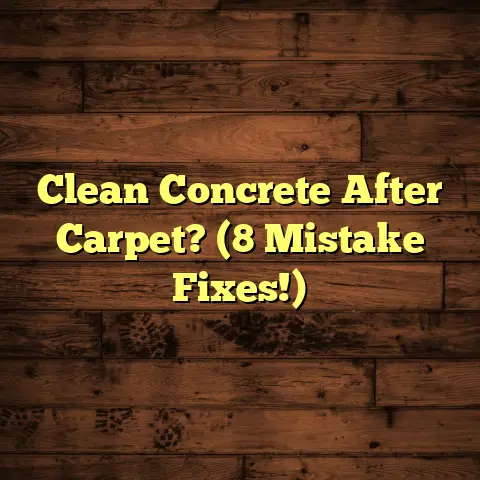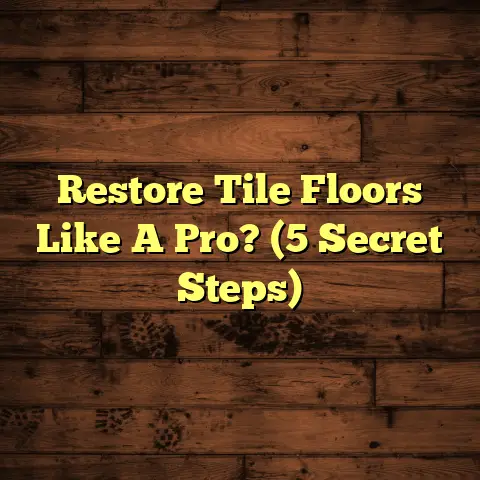Vinyl Over Linoleum? (2 Hour Install Hack!)
Flooring – it’s the foundation of every room,
literally!
And let’s be honest, it can be a real
headache.
I’ve seen it all in my years as a
flooring contractor, from cracked tiles to warped
hardwood.
But today, I’m excited to share a
game-changing hack that can transform your space
in just a couple of hours.
We’re talking about installing vinyl flooring directly over existing linoleum!
Yep, you heard that right.
No messy demolition,
no back-breaking labor, just a quick and easy
upgrade that’ll leave your room looking brand new.
Why is vinyl flooring so popular these days?
Well, for starters, it’s incredibly versatile,
durable, and budget-friendly.
Plus, with the
amazing designs available now, you can achieve
the look of hardwood, tile, or even stone without
breaking the bank.
In this article, I’m going to walk you through the entire process, step-by-step, so you can confidently tackle this project yourself.
I’ll share my insider tips and tricks to ensure
a flawless, professional-looking finish.
So, grab
your tools, put on your favorite playlist, and
let’s get started!
Understanding Vinyl Flooring
Before we dive into the installation process, let’s
talk about vinyl flooring itself.
It’s come a
long way since the days of your grandma’s kitchen!
Today, you’ll find a wide range of options, each with its own unique characteristics and benefits.
- Vinyl Sheets: These come in large rolls and
offer a seamless, waterproof surface.
They’re ideal for bathrooms and kitchens where moisture is a concern. - Vinyl Tiles: Individual squares that can be
arranged in various patterns.
They’re easy to install and replace if damaged. - Vinyl Planks: Designed to mimic the look of
hardwood flooring.
They offer a realistic wood grain texture and are incredibly durable.
But what makes vinyl flooring so appealing?
Well, for starters, it’s incredibly durable.
High-quality vinyl can withstand heavy foot traffic,
scratches, and spills, making it perfect for busy
households.
According to the Vinyl Institute, vinyl flooring
is known for its resilience and long lifespan,
often exceeding 10-20 years with proper maintenance.
https://www.vinylinfo.org/
It’s also incredibly water-resistant, making it an excellent choice for kitchens, bathrooms, and laundry rooms.
Unlike hardwood, vinyl won’t warp or swell when exposed to moisture.
And let’s not forget about maintenance!
Vinyl flooring is incredibly easy to clean.
A simple sweep and mop are all you need to keep
it looking its best.
No need for expensive cleaning
products or complicated routines.
But perhaps the biggest draw of vinyl flooring is its versatility in design.
You can find vinyl flooring in virtually any color,
pattern, or style imaginable.
Whether you’re going
for a modern, minimalist look or a rustic, farmhouse
vibe, there’s a vinyl flooring option that will
perfectly complement your décor.
I’ve personally used vinyl flooring in countless projects, and I’m always amazed by the transformations it can achieve.
It’s a cost-effective way to update your space without sacrificing style or durability.
Why Install Vinyl Over Linoleum?
Now, let’s get to the heart of the matter: why would you want to install vinyl flooring over existing linoleum?
Well, there are several compelling reasons.
First and foremost, it’s a huge time-saver.
Removing old flooring can be a messy, labor-intensive
process.
You have to tear up the old material,
scrape away adhesive, and dispose of the debris.
By installing vinyl directly over linoleum, you can skip all of that and save yourself hours of work.
Plus, you’ll avoid the added expense of demolition and disposal fees.
But the benefits don’t stop there.
Installing vinyl over linoleum is also a great way to reduce waste and minimize your impact on the environment.
Instead of sending your old flooring to the landfill, you’re essentially recycling it by using it as a subfloor.
This is especially important if you’re trying to live a more sustainable lifestyle.
And let’s be honest, who isn’t these days?
Another key advantage is cost-effectiveness.
Removing old flooring can be surprisingly expensive.
You may need to hire a professional demolition
crew, rent special equipment, and pay for disposal
fees.
By skipping this step, you can save a
significant amount of money.
This makes installing vinyl over linoleum a great option for rental properties, quick renovations, or anyone on a tight budget.
I’ve seen landlords transform entire apartments in a single weekend using this method, and the results are always impressive.
Of course, there are certain situations where installing vinyl over linoleum may not be the best option.
If your existing linoleum is severely damaged, loose, or uneven, it’s best to remove it before installing new flooring.
Otherwise, you may end up with an uneven surface that compromises the look and durability of your new vinyl flooring.
But in most cases, if your linoleum is in reasonably good condition, installing vinyl over it is a perfectly viable and cost-effective solution.
Preparing for Installation
Alright, now that we’ve covered the basics, let’s get down to the nitty-gritty: preparing for installation.
This is a crucial step that will determine the success of your project.
Proper preparation will ensure a smooth, even surface for your new vinyl flooring and help it adhere properly.
First, let’s gather our tools and materials.
Here’s what you’ll need:
- Vinyl Flooring: Choose the type, color, and
style that best suits your needs and preferences.
Make sure you order enough to cover the entire area, plus a little extra for waste. - Adhesive: Depending on the type of vinyl
flooring you choose, you may need adhesive.
Check the manufacturer’s recommendations to determine the best type of adhesive for your project. - Measuring Tape: Essential for accurately measuring the area and cutting the vinyl flooring.
- Utility Knife: For cutting the vinyl flooring
to size.
Make sure you have plenty of sharp blades on hand. - Straight Edge: A metal ruler or level will help you make straight, accurate cuts.
- Pencil: For marking cutting lines on the vinyl flooring.
- Seam Roller: For ensuring proper adhesion and a seamless look, especially with vinyl sheets.
- Cleaning Supplies: You’ll need a broom, vacuum cleaner, and cleaning solution to prepare the linoleum surface.
Once you have all your tools and materials, it’s time to prepare the linoleum floor.
Start by thoroughly cleaning the surface.
Sweep or vacuum the floor to remove any dirt, dust,
or debris.
Then, use a damp mop and a mild cleaning
solution to scrub the floor.
Pay special attention to areas with stains or spills.
You want to make sure the surface is completely clean and free of any residue that could interfere with adhesion.
Next, inspect the linoleum for any damages.
Look for cracks, chips, or loose areas.
If you
find any, you’ll need to address them before
installing the vinyl flooring.
Small cracks can be filled with a patching compound designed for linoleum.
Loose areas can be re-glued using a strong adhesive.
Make sure the linoleum is firmly adhered to the subfloor.
If it’s loose or peeling in any areas, it could cause problems down the road.
You may need to use a scraper to remove any loose pieces and then apply adhesive to re-attach the linoleum to the subfloor.
One of the most important steps in preparing for installation is acclimating the vinyl flooring.
This means allowing the vinyl flooring to adjust to the temperature and humidity of the room before you install it.
This will help prevent warping or buckling after installation.
Simply unroll the vinyl flooring and lay it out in the room for at least 24-48 hours before you begin the installation process.
This will give it time to expand or contract as needed, ensuring a perfect fit.
I know it can be tempting to skip this step, but trust me, it’s worth the wait.
Acclimating the vinyl flooring will make a huge difference in the final result.
The 2-Hour Installation Process
Alright, folks, this is what we’ve all been waiting for: the 2-hour installation process!
I know it sounds ambitious, but with proper preparation and a little bit of elbow grease, you can definitely transform your space in just a couple of hours.
I’ve done it countless times, and I’m confident you can too.
Let’s break down the process into manageable steps:
Step 1: Measuring the Area (15 minutes)
The first step is to accurately measure the area where you’ll be installing the vinyl flooring.
Use your measuring tape to determine the length and width of the room.
If the room is not perfectly square, measure the longest and widest points.
It’s always better to have a little extra than not enough.
Once you have your measurements, calculate the total square footage of the room.
This will help you determine how much vinyl flooring you need to order.
I always recommend adding an extra 10% to account for waste.
This will ensure that you have enough material to cover the entire area, even if you make a few mistakes along the way.
Step 2: Cutting the Vinyl (45 minutes)
Now comes the fun part: cutting the vinyl flooring to fit the dimensions of the room.
This is where your utility knife, straight edge, and pencil will come in handy.
Start by unrolling the vinyl flooring and laying it out on a flat surface.
Use your measurements to mark the cutting lines on the back of the vinyl.
Be sure to account for any corners, obstacles, or doorways.
I find it helpful to use a template for tricky areas like corners or curves.
You can create a template out of cardboard or paper and then trace it onto the vinyl.
When cutting the vinyl, use a sharp utility knife and a straight edge to ensure a clean, accurate cut.
Apply firm, even pressure and follow the cutting lines carefully.
It may take a few passes to cut through the vinyl completely.
Don’t try to force it. Just keep applying pressure until the blade cuts through.
For vinyl planks, you can use a scoring and snapping method similar to cutting laminate flooring.
Score the vinyl with your utility knife and then snap it along the score line.
This is a quick and easy way to cut vinyl planks, especially for straight cuts.
Step 3: Applying Adhesive (If Necessary) and Laying the Vinyl (30 minutes)
Whether or not you need to apply adhesive depends on the type of vinyl flooring you’re using.
Some vinyl flooring comes with a peel-and-stick backing, which eliminates the need for adhesive.
Simply peel off the backing and press the vinyl into place.
Other types of vinyl flooring require adhesive.
In this case, you’ll need to apply a thin, even layer of adhesive to the linoleum surface using a trowel.
Follow the manufacturer’s instructions for the specific type of adhesive you’re using.
Once the adhesive is applied, carefully lay the vinyl flooring into place.
Start in one corner of the room and work your way across, smoothing out any wrinkles or bubbles as you go.
Use a seam roller to ensure proper adhesion, especially along the seams.
Apply firm, even pressure and roll the seam roller along the seams to create a seamless look.
For vinyl planks, simply align the planks and press them into place.
Most vinyl planks have a tongue-and-groove system that allows them to snap together easily.
Make sure the planks are properly aligned and snapped together tightly to create a seamless surface.
Step 4: Ensuring Proper Alignment and Seams (15 minutes)
Once you’ve laid all the vinyl flooring, take a step back and inspect your work.
Make sure the vinyl is properly aligned and that there are no gaps or overlaps.
Pay special attention to the seams.
You want to
make sure they’re as seamless as possible.
Use a seam roller to smooth out any imperfections and ensure proper adhesion.
If you find any areas that need to be adjusted, carefully lift the vinyl and reposition it.
It’s easier to make adjustments while the adhesive is still wet.
Step 5: Finalizing the Installation (15 minutes)
The final step is to finalize the installation by rolling out the flooring and ensuring it adheres properly.
Use a heavy roller to roll out the entire surface of the vinyl flooring.
This will help ensure that the vinyl is firmly adhered to the linoleum and that there are no air pockets or bubbles.
Pay special attention to the edges and corners.
You want to make sure they’re properly sealed and adhered to the surface.
Once you’ve rolled out the flooring, allow the adhesive to dry completely before walking on it.
Follow the manufacturer’s instructions for drying time.
Finishing Touches
Now that your new vinyl flooring is installed, it’s time to add the finishing touches that will really make your space shine.
One of the most important finishing touches is baseboards and trim.
Baseboards and trim not only add a decorative element to your room, but they also help to protect the walls from damage.
If you already have baseboards and trim in place, you may need to adjust them to accommodate the new vinyl flooring.
You can do this by removing the baseboards and trim and then re-installing them slightly higher to cover the edge of the vinyl flooring.
If you don’t have baseboards and trim, now is the perfect time to install them.
Choose a style that complements your décor and install them using nails or adhesive.
Another important finishing touch is cleaning and maintaining your new flooring.
Vinyl flooring is incredibly easy to clean and maintain.
Simply sweep or vacuum the floor regularly to remove any dirt, dust, or debris.
Then, use a damp mop and a mild cleaning solution to clean the floor.
Avoid using harsh chemicals or abrasive cleaners, as they can damage the vinyl.
I recommend using a cleaning solution specifically designed for vinyl flooring.
These solutions are gentle yet effective at removing dirt and grime without damaging the surface.
To protect your vinyl flooring from scratches and scuffs, use furniture pads under the legs of your furniture.
This will help prevent scratches and scuffs when you move your furniture around.
You can also use rugs or mats in high-traffic areas to protect the flooring from wear and tear.
Conclusion
So, there you have it: a complete guide to installing vinyl flooring over linoleum in just two hours!
I know it sounds like a daunting task, but with proper preparation and a little bit of effort, you can definitely achieve a professional-looking result.
Remember, the key to success is to take your time, follow the instructions carefully, and don’t be afraid to ask for help if you need it.
Installing vinyl over linoleum is a cost-effective, time-saving, and environmentally friendly way to update your space.
It’s a great option for rental properties, quick renovations, or anyone on a tight budget.
Plus, it’s a fun and rewarding DIY project that will leave you feeling proud of your accomplishments.
So, what are you waiting for?
Grab your tools,
put on your favorite playlist, and get started!
I guarantee you’ll be amazed at the transformation you can achieve in just a couple of hours.
And don’t forget to share your experiences or ask questions in the comments below.
I’m always happy to help!





